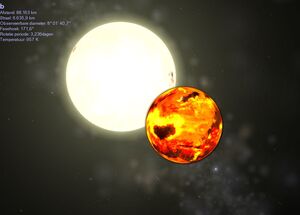The term 'hot planet' is not an official one. It is referred to planets orbiting a star or free floating through space (or satellites), that are hot enough to glow, or at least they emit a significant amount of infrared energy, far more then what they receive from their hosting star. They might have an unconventional Habitable Zone.
Theory[]
A hot planet is below the mass of Brown Dwarfs, so fusion reactions are impossible. They are cooling fast, too fast to support a Habitable Zone for a long time, but maybe enough for an orbiting colony.
In theory, there are 3 ways a hot planet can exist (and a possible 4th in future). The first way is by matter accretion. All planets in Solar System, when they first were formed, were hot. Rocky planets were covered by molten lava. So, a hot planet can form in orbit around a star (or hot moon can form in orbit around a planet). It is also possible that a small amount of interstellar gas and dust can collide to form a planet and not a star. So, interstellar planets can be formed this way. If the accretion process is very slow, that planet will have enough time to cool and will never be a hot planet. One example is S Ori 52.
A second way a planet can become glowing hot, is thanks to a cataclysmic impact with a large asteroid or with another planet. In such a collision, if one planet survives, its crust will be instantly destroyed, leaving behind an ocean of magma.
The third way of creating a glowing hot planet is by radioactive decay. For this, it is required that the planet will have enough uranium ores (or other radioactive elements). It is supposed that some asteroids were molten and shaped this way.
Finally, the 4th way for this to happen, is human engineering. The crust of a planet can be blown away with powerful explosions or with a controlled collision. For a gas giant, nuclear fusion can be used. This has not been done yet.
Hot planets can be of many types. The only ones known are gas giants, because they are larger and they need more time to cool down. Gas giants also have advantage of their gas ocean, that allows mater to circle and heat from the inside, while a rocky planet will start to develop a crust very fast, trapping heat inside.
Volcanic activity, created by massive tidal stress, is not enough to break apart the planet's crust and to create large oceans of magma.
A hot planet must not be confused with a planet orbiting its star very close. Even if both have high temperatures, the first emits far more heat then it receives, while the second is in (or close to) equilibrium.
Hosted moon[]
A moon can orbit a red-glowing planet. Of course, it should be interesting why that moon is cold or why it did not parish in the catastrophic collision. For gas giants, their moons might have time to create a solid crust. In case of a collision, a lucky moon can be outside the trajectory. And also, that moon can be a captured body into orbit. No matter the origin, if it is at the correct distance, heat from the planet can keep water liquid on the moon, even in interstellar environment. Light will be too dim for plants to grow. However, if the planet orbits a star, that star can be an extra source of light. So, we are not talking about a classic Habitable Zone, but about a body with liquid water. Also, since the planet and its moon need to be very close in order to have enough heat, both bodies will be tidal locked.
There is, however, one exception. As theorized in Artificial sun, a large enough gas giant can be heated until its surface reaches 3000 K or even higher. At this temperature, a Habitable Zone could be created, with the comfort zone at 7 million km (0.05 AU). Because of internal heat, the planet will also increase its size.
Why should someone blow a planet to transform it into a glowing-hot one? The most plausible reason must be to use it as a garbage canister. If the planet is molten, all toxic wastes will disseminate fast. Heat might destroy some, while others will mix with the molten lava. Heavy elements (like those obtained from nuclear plants) will simply submerge into the core of that planet, because of their great mass.
Hot planets are rare and don't offer too many alternatives for terraforming.
Natural heated hot planets[]
Main article: Rocky Planets (Theoretical Models)
If a planet is too close to its parent star, average temperature will be above 1000 C. Only few minerals will be solid at that temperature. The planet will be liquid and all substances will boil or sublimate, creating an atmosphere that will be blown away by extreme heat and by the solar wind.
In order for temperatures to be at 2000 degrees, the planet must have a Solar Constant of 4600. This would place a natural hot planet at the following distances:
- Around M - type stars - 180 000 km (below Roche limit, so the planet will break into a ring)
- Around K - type stars - 2.5 million km (also, close to Roche limit)
- Around G - type stars - 3 million km
- Around F - type stars - 9 million km
- Around A - type stars - 17 million km
- Around B - type stars - 160 million km (Earth's orbit)
- Around O - type stars - 9000 million km.
Losing mass, these planets will behave like comets, creating long tails behind them. The major difference is that tails will be made of sand and not of water. In turn, the tails will interact with solar magnetic fields and will create huge radiation belts.
